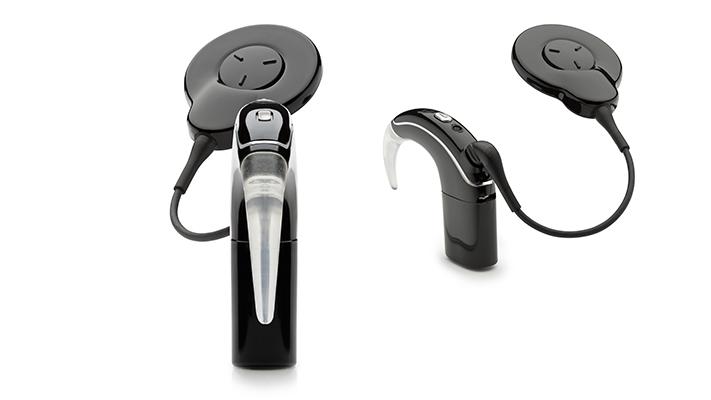cochlear
Latest

Amazon Fire TV devices can now stream audio directly to Cochlear hearing implants
Amazon and Cochlear have teamed up on a new feature that streams audio directly from Fire TV devices to hearing implants, using the Audio Streaming for Hearing Aids (ASHA) protocol.

Apple adapted Bluetooth LE for ultra-low power hearing aids
Last month, Apple and Cochlear teamed up to showcase the latter's new made-for-iPhone implant for folks with hearing loss. Now, Wired has revealed that the pair had to stretch the boundaries of possibility to make one of its signature functions work. After all, pushing audio from a phone to any sort of earpiece will rinse its battery, which ain't great for hearing aids that are in constant use. That's why Apple cooked up a way to push audio to devices using a tweaked version of the Bluetooth Low Energy protocol.

Apple and Cochlear team up on made-for-iPhone hearing implant
We've known that Apple has an interest in iOS-based hearing aids for some time, as they've worked with various manufacturers to bring these devices to the market. Now, Cochlear has teamed up with Apple to make the first cochlear implant sound processor that is specifically made for the iPhone. The Nucleus 7 Sound Processor, which promises to be both the smallest and lightest behind-the-ear device of its kind that's currently available, was approved by the FDA back in June.

Amped-up ear implant helps to re-grow auditory nerves
Cochlear implants already help those with auditory damage to hear better, but what if they could also grow new nerves while they're there? Scientists at the UNSW have discovered a way to do just that, at least in hamsters. After they introduced a gene therapy solution, a modified cochlear implant used electrical pulses to deliver the treatment directly to auditory nerve cells. That successfully re-generated so-called neurotrophins in the animals, which in turn aided nerve development and significantly improved the implant's effect. Such therapy could one day help the hearing-impaired to pick up sounds better, especially the subtle tones in music. There's a long ways to go prior to human trials, however, since it was only effective in the hamsters for a short time. But it could one day be included as part of cochlear implant therapy and even help other nerve-related conditions, like Parkinson's disease or depression. [Image credit: UNSW Translational Neuroscience Facility]

Accelerometer mic could change the way we look at cochlear implants
Hearing aids aren't the most discreet cybernetic creations, because the need for a clog-free microphone means that they generally need an external component. Engineers at the University of Utah and Case Western Reserve University in Cleveland aim to change everything with a much smaller mic that uses an accelerometer to detect sound vibrations -- so it requires no opening and can be inserted right into the ear. The only exterior hardware is the charger -- worn exclusively at night. Clinical trials in living humans begin approximately three years from now, and if you're looking forward to using this new device, removal of the incus (or anvil bone) in the middle-ear must first take place to optimize effectiveness of the new implant. We never said it'd be pretty.

Trouble hearing? Advanced Bionics' waterproof implant is paddling your way
If you're one of the 200,000 deaf people who've received cochlear implants, then here's an upgrade worth considering: the Neptune from Advanced Bionics claims to be "the world's first and only swimmable, waterproof sound processor," and it's just received certification for the US and Canada. Read on for more details in the full press release and soon you could be bantering while you bathe.

Bone-anchored hearing aids filter out noise, finally ready for human implantation
Think those noise-canceling earbuds are hot stuff? Imagine if said technology was applied to an advanced type of implantable hearing aid, and you'll have an idea of exactly what Earthlings with severe hearing loss now have to look forward to. For years now, we've watched as cochlear implants became more effective in lab tests, and up until recently, we've had strict medical testing procedures to thank for the inability to actually get one. Now, one Colin Hughes will soon be amongst the first Australians to enjoy a "new bone-anchored hearing aid designed to adjust to noisy environments, quiet conversations and the varying rhythms and pitch of music." Due to a birth defect that left him with atypically narrow eustachian tubes, Colin was never able to take advantage of traditional hearing aids for any length of time, but now these $12,000 (per pair) devices are promising a new life for the 70-year old bloke. Our favorite feature? MP3 players can be directly (and discretely) attached, enabling old geezers to tune out old hags without them ever noticing.[Thanks, Mike]

Carina implantable hearing aid gets showed off
We've been hearing about cochlear implants of various sorts some time for some time now, but it looks things are about to get a whole lot more implantable, with a pair of fully implantable hearing aids now in clinical trials. One of those is developed by the folks at Envoy Medical, while the other comes from Otologics of Boulder, CO, which the MIT Technology Review got to check it out first hand, so to speak. Dubbed "Carina," the hearing aid consists of four separate pieces that are designed to be countersunk into the skull, including a microphone the size of a fingernail that sits behind the ear and a main processing unit that also houses the rechargeable lithium-ion battery that powers the device. That, as you're no doubt wondering, gets replenished by a charging unit that's held in place with a magnet and must be worn for an hour or two a day. As the Review heard straight from one of the device's early users, the entire setup appears to work remarkably well, delivering a "natural feeling of hearing." As it's quick to point out, however, the device still has a long ways to go, with the study currently only having twelve of the 70 to 80 users it needs to complete "phase II" of the trials. And, of course, there's that small matter of price, with the Carina currently ringing in at a cool $20,000 (for one ear), none of which is covered by insurance.

Auditory nerve implant could drastically benefit deaf individuals
Early last year, gurus at the University of Michigan were devising a newfangled type of cochlear implant, but now it looks like the Wolverines are more interested in a fresh auditory nerve implant that is being dubbed "a superior alternative" to the (now) old fashioned option. The uber-thin electrode array would purportedly "transmit a wide range of sounds to the brain," and could give profoundly and severely deaf people the ability to "to hear low-pitched sounds common in speech, converse in a noisy room, identify high and low voices, and appreciate music." Researchers on the project are convinced that this technology trumps cochlear implants in every way, and while preliminary patents have already been filed, it'll still be nearly a decade at best before these things can invade human ears en masse.[Via Physorg]







